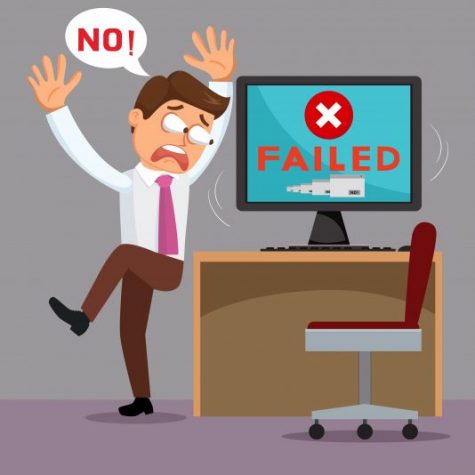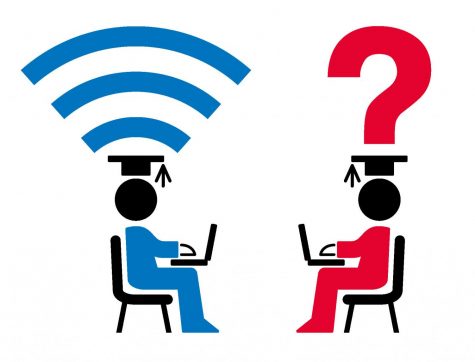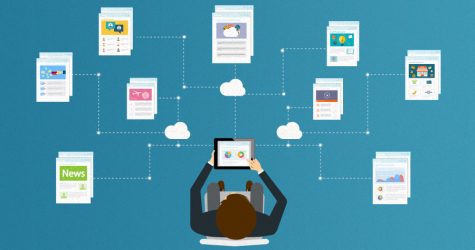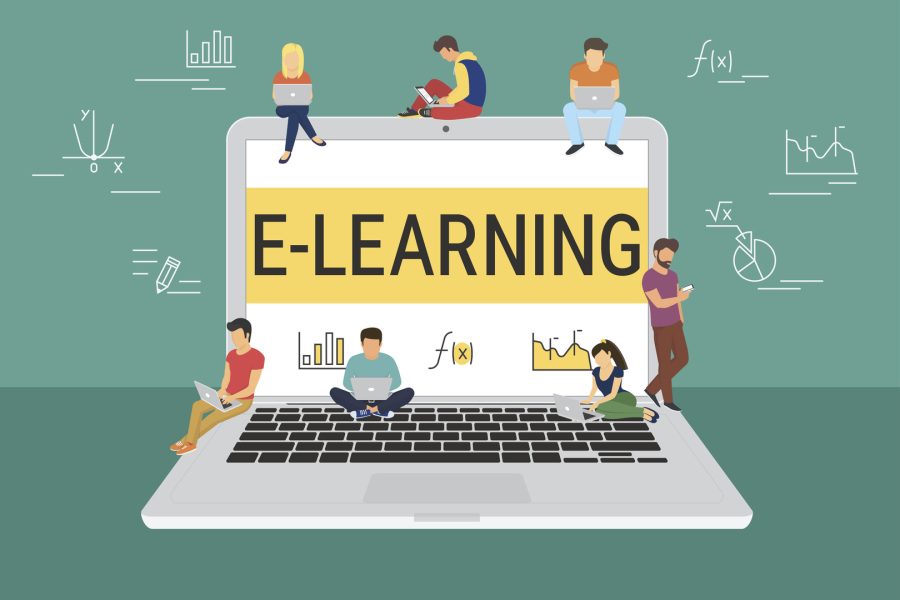The Benefits and Blindspots of E-learning
April 23, 2020
This year, GPS joined a large number of school corporations around the United States who have taken part in a new concept of learning entitled, “e-learning.” This was put into action so students wouldn’t have to make up snow-days at the end of the school year, and instead complete all of their assigned work for that day from home via the internet. In recent weeks, the introduction of a global pandemic entitled, “Coronavirus Disease” (COVID-19), has since prevented public gatherings around the world and shut down many events as well as local businesses. COVID-19 is an upper respiratory disease that has led to multiple people becoming infected because of how quickly it can spread. This has since quarantined most people to their homes, which has forced schools around the world to suspend in-person classes for multiple weeks at a time. For GPS, in-person classes have been suspended for the rest of the year, and students must rely on e-learning to pass the fourth quarter. For seniors, they have to rely on it to graduate from high school. In my opinion, just because we have to do something, it doesn’t mean that we necessarily should. With all of the advantages this new chapter of our lives brings us, there are also many disadvantages that most don’t acknowledge when trying to learn a whole quarter of school online.
Transitioning to e-learning for the rest of the school year has been a very stressful process. There are so many questions about this new concept that have been left unanswered, and the reasoning is because this is something GPS has never done before. Although we have had a few e-learning days this school year for standardized testing, it wasn’t as extreme or important as it is today. Where most teachers would just have assigned a worksheet to complete or a YouTube video to watch knowing that they would see their students the next day, now they have to teach their students as if they are still in the classroom. This means quizzing, testing, and doing final projects over the internet. I believe that claiming e-learning should feel like you’re still in the classroom is a false idea, because e-learning doesn’t have the same effect as in-person classes. When students go to school they are confronted with the work everyday. Their teachers stress how important it is to complete everything. Being at home makes it easier for students to refuse to do their work, while telling their parents that they did. The temptations of treating this as a long summer break sets in, and I believe most students won’t do their work at all because of this. Grades for the fourth quarter of school are going to decrease dramatically, and it’s because students simply don’t care about their work anymore. Everything is online now, so it shouldn’t be taken as seriously right? Wrong. If students don’t feel like they need to complete their work as if they were still in school, then clearly e-learning isn’t as effective as we all thought it could be. Completing e-learning for a few days compared to doing it for months is a vast difference that I believe most don’t realize.
 Another reason why I think e-learning will hurt students’ grades is because of all the underlying technical issues and the leniency students receive because of it. The platform that GPS uses for grades and now for e-learning, Unified Classroom, has been very difficult to log onto. The traffic of millions of students using the website has inconvenienced me as well as other students when trying to turn in assignments or even complete them. While I do think that students deserve extra days to complete work because of this issue, on the other hand, I think some students are using this extra time and the known technical issues to their advantage. Receiving an assignment that isn’t due for another week can cause students to do all of their e-learning at the last minute, or even forget about it and not do it at all. They use the time they should have to complete the work to lounge and relax at home. If they also have an assignment due at a certain time and it’s not completed, they can email their teachers and claim they’re still having technical issues when they are really just plain lazy. I don’t think it’s fair to the students that always turn in their work on time and take e-learning seriously so they can pass.
Another reason why I think e-learning will hurt students’ grades is because of all the underlying technical issues and the leniency students receive because of it. The platform that GPS uses for grades and now for e-learning, Unified Classroom, has been very difficult to log onto. The traffic of millions of students using the website has inconvenienced me as well as other students when trying to turn in assignments or even complete them. While I do think that students deserve extra days to complete work because of this issue, on the other hand, I think some students are using this extra time and the known technical issues to their advantage. Receiving an assignment that isn’t due for another week can cause students to do all of their e-learning at the last minute, or even forget about it and not do it at all. They use the time they should have to complete the work to lounge and relax at home. If they also have an assignment due at a certain time and it’s not completed, they can email their teachers and claim they’re still having technical issues when they are really just plain lazy. I don’t think it’s fair to the students that always turn in their work on time and take e-learning seriously so they can pass.
Junior Alexis Barkey said, “I honestly don’t like e-learning all that much, because all of the technical issues we’ve experienced so far make it hard to keep up with the work in my classes. I miss having the teachers teach us in-person. We didn’t have to go through Unified Classroom to turn in all of our assignments or access them when we needed to.”
My final statement about the disadvantages of e-learning is that no matter how stressed it is that this  period of time should feel like you’re still in class, it just doesn’t. Normally we wouldn’t have school every other week leaving a gap of time for students to forget everything they learned the week before. Normally there would be little to no things getting in the way of each student being taught everything they are supposed to. Whether it’s frustrating technical issues or the student’s non-willingness to adapt to change and learn via online for an extended period of time, I definitely believe that grades will decrease a great amount. Although I do acknowledge that there are some students that don’t do their work in-class, e-learning will only make this worse. I know that we really don’t have any other options during these hard times with this being the first year of e-learning and something is better than nothing. I think that in the next coming years, GPS will advance e-learning technology to make it next to impossible to not complete assignments so students can get the learning they deserve. Whether this be making it mandatory to have class video calls, using a new platform, or just having more time to adjust to the concept, I believe this rough e-learning process will improve upon itself and things will get better with time.
period of time should feel like you’re still in class, it just doesn’t. Normally we wouldn’t have school every other week leaving a gap of time for students to forget everything they learned the week before. Normally there would be little to no things getting in the way of each student being taught everything they are supposed to. Whether it’s frustrating technical issues or the student’s non-willingness to adapt to change and learn via online for an extended period of time, I definitely believe that grades will decrease a great amount. Although I do acknowledge that there are some students that don’t do their work in-class, e-learning will only make this worse. I know that we really don’t have any other options during these hard times with this being the first year of e-learning and something is better than nothing. I think that in the next coming years, GPS will advance e-learning technology to make it next to impossible to not complete assignments so students can get the learning they deserve. Whether this be making it mandatory to have class video calls, using a new platform, or just having more time to adjust to the concept, I believe this rough e-learning process will improve upon itself and things will get better with time.
In my opinion, the disadvantages of e-learning outweigh the advantages, but that doesn’t mean that there aren’t any to acknowledge. E-learning is still giving students different assignments and websites to use based on what they should be learning in class. Most teachers are sticking to the curriculum and started their e-learning where they left off teaching in class. This makes it easy for students to pick up where they last left off and decreases the amount of confusion about what they are learning that week. I think what has been the most helpful for me and other students is the instructions teachers have given over all of their assignments. Each of them post on their class page with lengthy paragraphs about the assignment for that day. They also have organized their class pages to adapt to these new circumstances with sections for different chapters and attendance polls. Teachers at GHS, such as Jenna Parker and Barbara Lail, have used their laptops and iPads to record videos of themselves going over slides of notes and helpful tips for completing assignments, as well as the instructions for each day of e-learning. They make it next to impossible to be confused about an assignment.

We all know that some students still do need help with certain topics though, which is why I think it’s very convenient that teachers are always constantly checking their emails for questions from students and respond back as quickly as they can. Contacting your teachers at GPS is never an issue, and the teachers stress to their students to use this to their advantage whenever they need to. The platforms teachers are using also helps aid students through this stressful time. Applications such as EdPuzzle, MathXL, Study Island, and more help students by quizzing them over the content customized by the teachers and preparing them for tests. Although this is not mandatory, teachers have also used an application called, “Zoom”, to have video conferences with their students when they can’t explain something by posting it on their class page. The advantages of e-learning are, in the end, very helpful for the students who are willing to do their work. Teachers try the best they can to get the concepts in our heads via online, and I greatly appreciate that since we all wish we could be in the classroom instead. The teachers are very sympathetic for their classes and are always willing to help their students if they want to learn. I believe the best part about e-learning is how easy the teachers make it for us students to pass their classes, even if it’s not the way we expected it to happen.
“I am trying to be as flexible as possible, because many students might be dealing with a lot right now at home,” said 10th and 11th grade history teacher, Jenna Parker. “I’ve done a few things differently that have been enjoyable, such as Zoom conferencing and making extra credit available to my students by having them participate in the positive sign project for the community. Also being able to add material into my lessons like video clips and map replicas has been refreshing because I don’t always have the time during the year to show secondary materials like that. I miss teaching in my actual classroom but there are some cool tech tools out there that can help facilitate the learning process.”
E-learning is a fairly new concept for GPS, and with new concepts come the advantages and disadvantages. We were thrown a curveball when we were forced to adapt to this new concept or multiple weeks at a time, and for some students it’s been hard to deal with. The fact is that in-person classes don’t have the same effect as e-learning classes, and completing a whole quarter of school online seems inclined for most students to not complete their work. I think grades will decrease for the fourth quarter, which won’t look good for our school corporation, but it is something we can’t get out of and have to adjust to. Teachers are making this process easier on the students by using websites and new technology in order to stick to the curriculum, and answering all of their students’ questions about the material in a timely fashion. The hope is that we can all move past this eventually and go back to our in-person classes, which is the best option for students if they want to learn what they are being taught more extensively. For now, students have to do the best they can to complete their work, take their tests, do their projects, and turn it all in on time through Unified Classroom. In conclusion, I think e-learning isn’t effective if students don’t take it seriously, but it’s all we have right now to get through the rest of the school year. Everyone should be mindful of this new change and do everything they possibly can to help themselves and others around them pass all of their classes under these circumstances.


